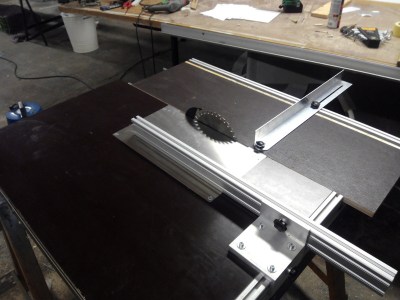If your parents had a workshop as you grew up, the chances are it harbored some tools you came to know and love as you used them for your formative projects. Our reader [Joerg]’s father for instance has a circular saw bench that [Joerg] sorely misses, now living over 500km away. Our subject today is his response to this problem, now needing to cut aluminium he set about creating a saw bench of his own, and the result is a rather nice build.
 He put together a variety of CAD models to formulate his ideas, and arrived at a structure in 18mm waterproof plywood with moving table linear bearings. The saw blade itself was mounted on a 5mm aluminum plate, though he doesn’t tell us what motor it uses. All the wooden parts came from a single sheet of plywood, and the result is a very tidy creation indeed.
He put together a variety of CAD models to formulate his ideas, and arrived at a structure in 18mm waterproof plywood with moving table linear bearings. The saw blade itself was mounted on a 5mm aluminum plate, though he doesn’t tell us what motor it uses. All the wooden parts came from a single sheet of plywood, and the result is a very tidy creation indeed.
Power saws are among the more hazardous tools in your workshop arsenal, whatever their type. If this was a commercial saw it would probably have a guard over the top of its blade, but even without that its sturdy construction and relatively low profile blade make this one stand above some of the more basic home-made saws we’ve seen. Building a power saw is something you have to take seriously.
We’ve featured quite a few home-made saws over the years. At least one other large table saw, a rather powerful but surprisingly tiny saw bench, this scroll saw using a sewing machine mechanism, or how about this simple jigsaw table?
















https://www.youtube.com/watch?v=eiYoBbEZwlk
But then people do it on purpose!
And now someone has a broken saw that needs repair.
Besides, most of us have 10 fingers. Built-in redundancy. :P
High humidity & green wood has also been known to trip the safety interlock.
“And that’s terrible.” :)
I like this one better. https://www.youtube.com/watch?v=6xBrtiEZDTg
I grew up using tools with no guards. I still have all 10, full length fingers. And toes. Among the guard less tools was a table saw.
The only time I used a saw with all the fancy safety features, I quickly disabled every one of them. They made the saw cut worse, and I simply kept my fingers out of the way.
And don’t get me started on anti-kickback features.
I agree. The saw gaurd that came with my el-cheapo saw table didn’t allow you to see the cut! And el-cheapo saw tables are small, so if you want to saw something big you can’t use a guide so you have to guide it by eye.
So that had to go quickly. So now every time I use the saw I remind myself that the machine could easily take my fingers off, and go in extra careful mode.
Hope you at least kept the splitter at the back, becuse without it you’re just tempting faith.
I have a nick in my finger because the saw literally pulls you in as it grabs the workpiece and throws it out. The force with which you push the piece against the table and fence gets re-directed when the piece flips and you find your hand heading straight for the blade.
Yes, I left the splitter/riving knife on the back. I wouldn’t have called it a “safety device” though. The little anti-kickback fingers that goes on that though, I disabled. The kick back I experienced was worse as a result of those blasted things.
The one I grew up on I don’t think shipped with any safety devices. Not even a blade cover or riving knife. How did I ever survive?
My only kick backs have always shot directly backward. The kick back that I experienced with the anti-kickback fingers was the same that went to shit quickly because of those fingers. If you listen to the way the saw sounds, you can tell when you’re pushing to fast.
My technique is to push the back edge of the board with my thumb, until I’m about 4 or 5″ away from the blade, then I’ll use a push stick. It’s also never directly in line with the blade. If I need guiding by the blade, I do that with a stick, again pushing a 45 against the side edge.
The board should never be pushed hard enough that it rises against the blade.
Not all table saw safety features are created equal, it’s very dangerous to lump them all together. Things like the blade guard can be discarded, they provide no benefit. However things like riving knives are incredibly critical safety features and you barely even notice they’re there. You need to evaluate each feature on its own and decide if it is appropriate for your application.
This guy demonstrates kickback: https://www.youtube.com/watch?v=u7sRrC2Jpp4
And even why he is super alert he still was very close to having his fingers pulled to the saw.
This wouldn’t have happened with riving knives. There are lots of videos on youtube showing people using circular saws without.
Don’t really understand why. If properly set up there is no disadvantage at al ofl using riving knives.
unless the riving knife is higher than the top of the blade, which is how mine came.
The motor is an old Maffell k85. I’ll post a pic when I’m back from office.
It’s funny that a circular saw cuts straight lines.
Lol. And a box-cutter can do much much more than its namesake suggest.
Imagine what one can do with a ‘hole saw’!